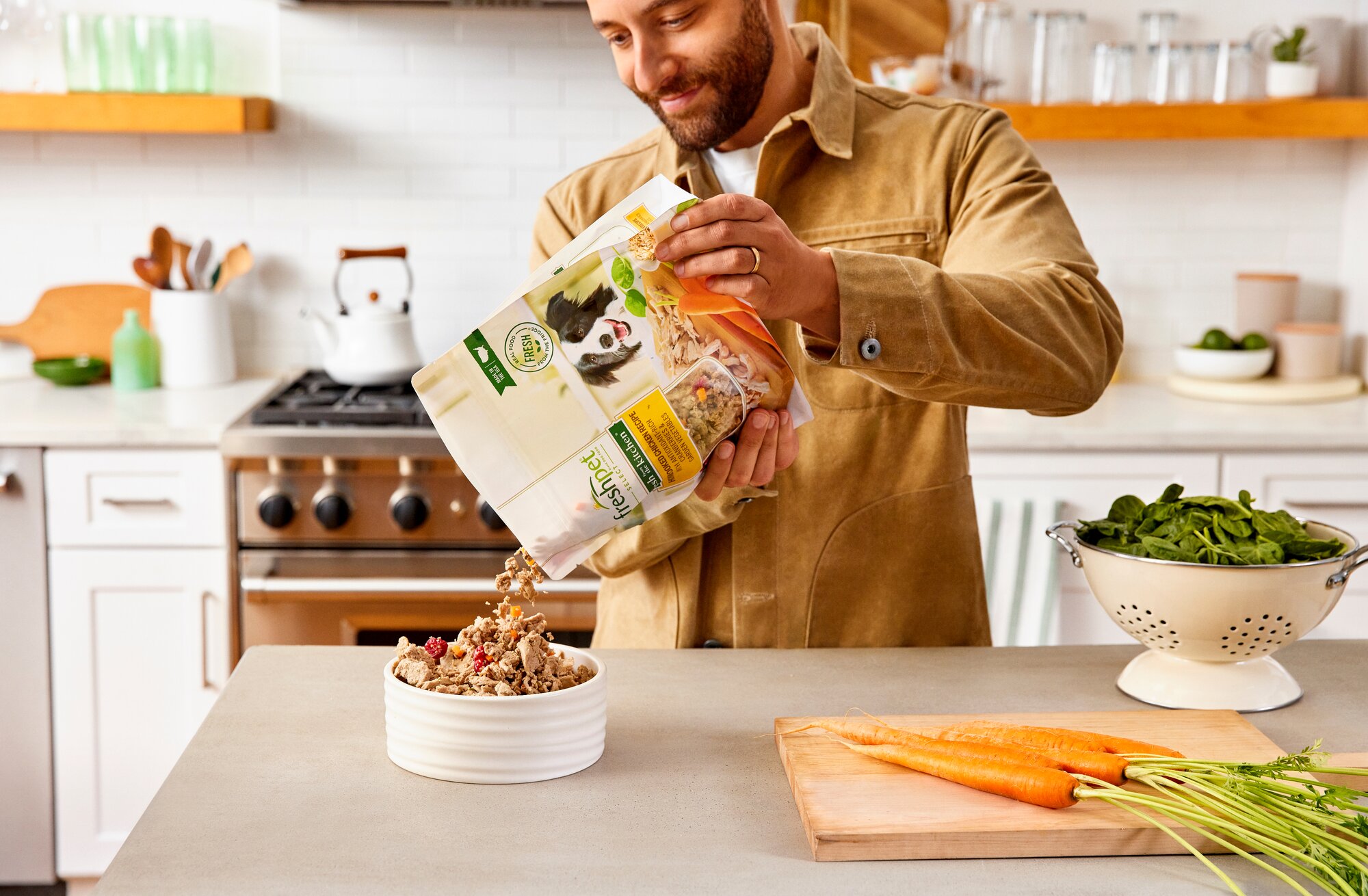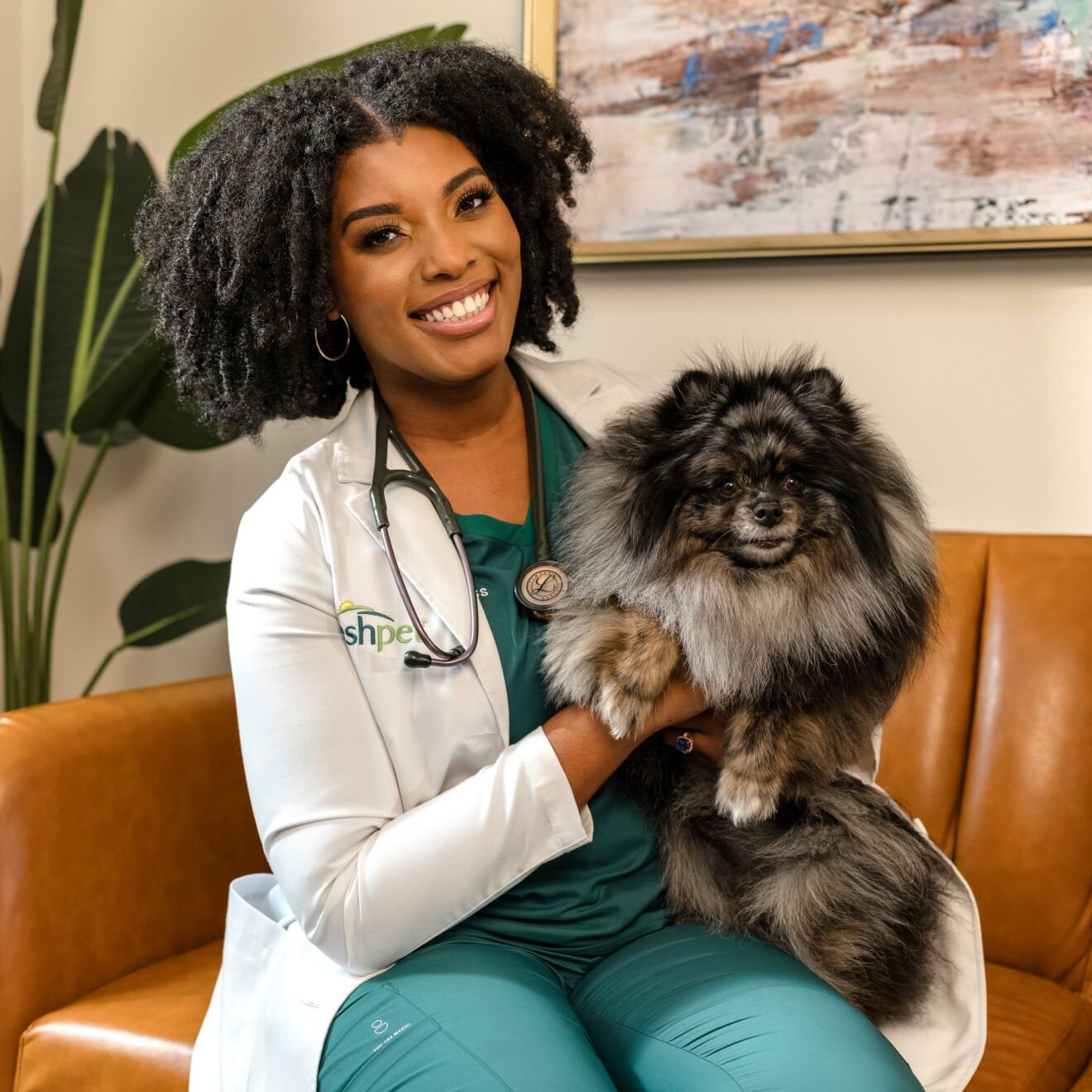popular searches

Nutrition Needs for Older Dogs
written by Freshpet Vet Team
Dogs are living longer, with nearly one-third of all dogs aged 7 or older.
This means that there are some physiological changes that often occur slowly and eventually become visible symptoms to pet parents. Over time, a veterinarian’s clients may notice mobility issues, dental decay, oral health deterioration, as well as declines in sight and cognition in their aging dogs.
For trained veterinary professionals, these changes are much more obvious during an annual wellness visit. It’s important that clinicians have conversations with pet parents about their dog’s aging, how their health and energy may decline in this stage of life, and how to adjust the pet’s nutrition and lifestyle accordingly.
Veterinary staff can approach the topic with their clients and explain that several nutritional strategies can be used to delay the progression of some of these physiological changes in nutrition, exercise, weight management, and dental care. Freshpet’s Vital Healthy Aging Roll is designed with the needs of aging dogs in mind.
Here are some ways a senior dog’s nutrition needs change how the food can support a healthy life in senior dogs.
A Senior Dog’s Nutrition Needs Pet Parents Can See.
As dogs age, the first change that a pet parent might notice is they slow down. Why this happens is not fully understood, muscle loss can occur as an animal ages. That’s one reason a higher-protein diet is often suggested to senior dogs; they need high-quality protein to maintain muscle mass and amino acid levels.
As the animal’s movement decreases, they burn fewer calories, and without portion control or a modified diet, weight gain can occur. Excess weight puts added pressure on joints, leading to increased inflammation and worsen mobility issues. Cartilage regeneration also slows with age, making joint problems even more pronounced.
Avoiding extra pounds on their frames can help these pets live longer, as leaner body condition scores are associated with fewer chronic diseases. [1] Freshpet has a lower caloric density, allowing dogs to feel fuller with fewer calories consumed.
Weight management through caloric restriction is important to discuss with clients. For patients with inflammation affecting joint health, practice staff can inform clients that a diet rich in EPA, antioxidants, and glucosamine can support joint function and reduce inflammation.
They’re more likely to have cognitive decline.
Many aging dogs experience cognitive decline. Doctors should talk to clients about symptoms they notice at home such as disrupted sleep patterns, forgetting house rules, or unusual behavior. Diets rich in omega-3s (particularly DHA), vitamin E, and selenium can help maintain cognitive function and slow the progression of dementia. [2] A balanced diet with sufficient vitamin B is also crucial, as vitamin B deficiencies are associated with cognitive decline.[3]
They have dental health concerns.
Veterinary staff know that dental issues, like tartar buildup and periodontal disease, often affect senior dogs. In severe cases, teeth may need to be extracted, leading to painful gums that make chewing difficult. Doctors can advise clients on managing their dog's dental health through regular hygiene and professional cleanings.
Veterinarians should emphasize that softer, fresh food is easier for dogs with dental issues to chew. This helps dogs get the nutrients they need, even after extractions, and supports recovery. It also reduces discomfort from dry food. Some practices will recommend Freshpet for a few days after dentals when gums are sensitive. Consuming food that has the correct amount of nutrients helps dogs fight off common diseases by themselves.
A Senior Dog’s Nutrition Needs Pet Parents Can’t See.
A senior dog’s immune system weakens with age, leading to oxidative damage in cells. Practice staff can inform clients that diets with antioxidants like vitamins C and E, as well as minerals like selenium and zinc, can boost immune function. (4) It’s also important that the food contains bioavailable amino acids to produce antibodies and support proper immune response. A balanced omega-6 to omega-3 fatty acid ratio, particularly with EPA, can help manage inflammation, while amino acids support glutathione production, an antioxidant that protects against oxidative stress. Ensuring appropriate levels of bioavailable methionine, crucial for antioxidant synthesis, is another way to support immune health.(5)
They’re more likely to have gut health issues.
Senior dogs often experience changes in their gut microbiome, leading to digestive issues such as constipation. A balanced intake of fermentable and non-fermentable fibers in their diet can help alleviate this. (6) Fermentable fibers promote the growth of healthy gut bacteria, supporting digestion, while non-fermentable fibers (not absorbed) help bulk up stools in the large intestine, aiding in their formation and passage. A diet higher in both types of fiber and moisture, like Freshpet senior recipes, help manage constipation, support healthy weight, and promote overall digestive health.
They’re at an increased risk for dehydration.
If a wellness exam indicates dehydration through signs like reduced skin elasticity, dry mouth, or lab results, veterinary staff should discuss potential causes with clients. Senior dogs may have a decreased sense of thirst, feel too tired, or experience mobility issues, making trips to their water bowl less frequent. Feeding high-moisture foods—like those in a fresh food diet—not only provide additional water but also helps maintain hydration. Fresh diets like Freshpet with a moisture content on average of 72%, compared to dry food with only 10%, can help prevent dehydration. Our internal research shows dogs on a fresh food diet have improved water intake. Additionally, fermentable fibers in the diet, once fermented in the large intestine, help absorb water, further aiding hydration. Wet pet food with high moisture content can also improve the animal’s health, likely due to better amino acid digestibility.(7)
Their vision may be declining.
Age-related eye issues, such as cataracts, can affect senior dogs. Once the dog has cataracts, there is nothing that can be done to improve circumstances from a nutritional standpoint. Diets rich in lutein and beta-carotene may help improve vision and slow the progression of cataracts, especially if started early. Some reports find that feeding dogs diets that are high in lutein and beta-carotene can improve visual acuity and slow cataract progression in aging dogs, especially before cataracts have developed. Freshpet foods have spinach and carrots as natural sources of lutein and beta-carotene, respectively.
Support Senior Dog’s Health with Fresh Dog Food.
It’s important practice staff remind clients that they need to take preventative actions and address senior dogs’ changing nutritional needs before issues progress. A fresh, balanced diet like Freshpet could help improve certain aspects of the senior dog’s health as they age.
The Freshpet Vital Healthy Aging Roll features a 93.2% protein digestibility rate, achieved through high-quality ingredients and gentle cooking methods. It also contains antioxidants, EPA, DHA, and glucosamine. Whether practitioners recommend the Freshpet Healthy Aging Roll or they’re looking for another Freshpet formula, it’s easy to sort by dietary need on the website and find a more appropriate recommendation.
References:
1. Kealy, Richard D., Dennis F. Lawler, Joan M. Ballam, Sandra L. Mantz, Darryl N. Biery, Elizabeth H. Greeley, George Lust, Mariangela Segre, Gail K. Smith, and Howard D. Stowe. “Effects of Diet Restriction on Life Span and Age-Related Changes in Dogs.” Journal of the American Veterinary Medical Association 220, no. 9 (May 1, 2002): 1315–20. https://avmajournals.avma.org/view/journals/javma/220/9/javma.2002.220.1315.xml
2. Scuderi, Caterina, and Lorenzo Golini. “Successful and Unsuccessful Brain Aging in Pets: Pathophysiological Mechanisms behind Clinical Signs and Potential Benefits from Palmitoylethanolamide Nutritional Intervention.” Animals : An Open Access Journal from MDPI 11, no. 9 (September 3, 2021): 2584. https://www.ncbi.nlm.nih.gov/pmc/articles/PMC8470385/
3. Bermingham, Emma N, Keely A Patterson, Anna K Shoveller, Karl Fraser, Christina F Butowski, and David G Thomas. “Nutritional Needs and Health Outcomes of Ageing Cats and Dogs: Is It Time for Updated Nutrient Guidelines?” Animal Frontiers: The Review Magazine of Animal Agriculture 14, no. 3 (June 20, 2024): 5–16. https://www.ncbi.nlm.nih.gov/pmc/articles/PMC11188961/
4. Larsen, Jennifer A., and Amy Farcas. “Nutrition of Aging Dogs.” The Veterinary Clinics of North America. Small Animal Practice 44, no. 4 (July 2014): 741–59, vi.
https://pubmed.ncbi.nlm.nih.gov/24951344/
5. Banton, Sydney, Júlia G Pezzali, Adronie Verbrugghe, Marica Bakovic, Katie M Wood, and Anna K Shoveller. “Addition of Dietary Methionine but Not Dietary Taurine or Methyl Donors/Receivers to a Grain-Free Diet Increases Postprandial Homocysteine Concentrations in Adult Dogs.” Journal of Animal Science 99, no. 9 (August 1, 2021): https://www.ncbi.nlm.nih.gov/pmc/articles/PMC8420682/
6. Yang, Qing, and Zhenlong Wu. “Gut Probiotics and Health of Dogs and Cats: Benefits, Applications, and Underlying Mechanisms.” Microorganisms 11, no. 10 (September 29, 2023): 2452. https://www.ncbi.nlm.nih.gov/pmc/articles/PMC10609632/
7. Kim, Ki Hyun, Kangmin Seo, Hyun-Woo Cho, Jung-Hwan Jeon, Chan Ho Kim, Jiyeon Jung, and Ju Lan Chun. “Age-Related Digestibility of Nutrients Depending on the Moisture in Aged Dogs.” Journal of Animal Science and Technology 63, no. 6 (November 2021): 1355–61. https://www.ncbi.nlm.nih.gov/pmc/articles/PMC8672265/


